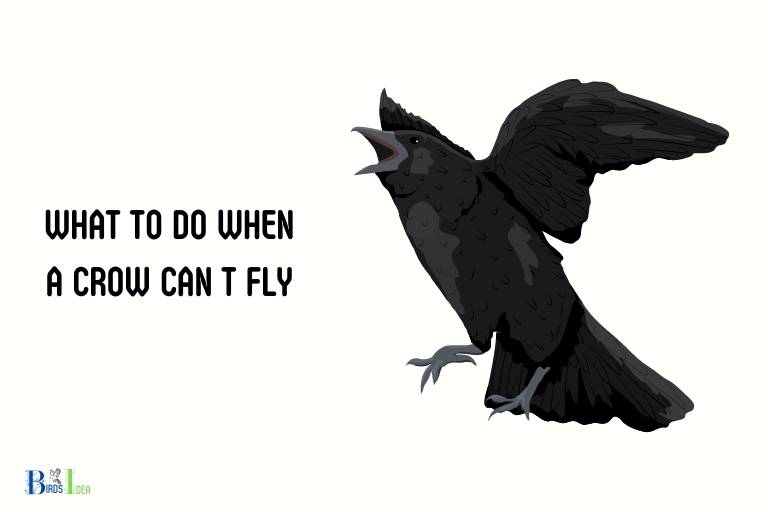What to Do When a Crow Can’t Fly? 10 Steps!
When a crow can’t fly, it is essential to evaluate the situation, provide immediate care, and contact a local wildlife rehabilitation center for professional assistance.
Crows are intelligent birds that can face various challenges, including injuries, illnesses, or being too young to fly.
In such cases, it’s crucial to understand the appropriate steps to help the crow without causing further harm or distress.
Avoid handling the crow unless necessary and never provide food or water without proper guidance.
Most importantly, contact a wildlife rehabilitation center or local expert to take over the care and ensure the crow’s safe return to the wild.
10 Steps to Take When a Crow is Unable to Fly
| Step | Action | Reason |
| 1 | Assess the situation | Determine if the crow is injured, a baby, or simply temporarily grounded. |
| 2 | Ensure safety | Keep pets and other animals away from the crow to avoid additional harm. |
| 3 | Provide aid | If the crow is injured, prepare a comfortable and safe space for it to rest (e.g., a shoebox with soft bedding). |
| 4 | Contact local wildlife rescue | Reach out to a nearby wildlife rescue or rehabilitation center for advice and assistance. |
| 5 | Provide food and water | While waiting for help, offer the crow water and appropriate food like insects, fruits, or seeds. |
| 6 | Monitor from a distance | Keep an eye on the crow but avoid stressing it by maintaining a safe distance. |
| 7 | Follow advice of experts | Listen to the guidance provided by wildlife professionals and follow their instructions. |
| 8 | Relocate if necessary | If advised by experts, gently move the crow to a safer location or transport it to a rehabilitation center. |
| 9 | Report progress | Keep the wildlife rescue informed about the crow’s condition and any changes in its situation. |
| 10 | Release when ready | If the crow recovers its flying ability, follow expert advice on proper release procedures. |
Key Takeaway

Five Facts About: A Crow Unable to Fly
Understanding The Causes Of Crow Flightlessness
When we think of crows, we often picture these intelligent birds soaring through the air with ease.
However, there are situations where a crow may become flightless, leaving them vulnerable and in need of assistance.
We will discuss the causes of crow flightless and what you can do to help these magnificent creatures.
Common Causes Of Crow Flightlessness
There are a few key factors that can lead to a crow’s inability to fly, including:
- Injuries: Like any animal, crows are susceptible to injuries that can affect their ability to fly. This can range from broken wings to other bodily damage.
- Illness: Some illnesses can impact a crow’s ability to fly. For example, if a bird contracts west nile virus or avian flu, they may become disoriented and unable to take flight.
- Genetic abnormalities: Occasionally, crows may be born with genetic abnormalities that interfere with their ability to fly.
The Role Of Injuries, Illness, And Genetic Abnormalities
Injuries: when a crow is injured, it can affect their ability to fly in a number of ways.
For example, a wing injury can make it impossible for the bird to launch into flight, while a leg injury can impact their ability to land safely.
It’s not uncommon for an injured crow to be found on the ground, unable to take off again due to their injury.
Illness: some illnesses can cause neurological damage that affects a crow’s ability to fly.
Additionally, certain illnesses can result in muscle weakness, making it difficult or impossible for the bird to lift off the ground.
If a sick crow is found on the ground, it’s important to contact a wildlife rehabilitation center for assistance.
Genetic abnormalities: while rare, some crows may be born with genetic abnormalities that affect their skeletal or muscle structure.
This can make it difficult or impossible for them to fly. Without intervention, these birds may be unable to survive in the wild.
How Environmental Factors Can Negatively Impact Crow Flight?
In addition to the factors listed above, there are a number of environmental situations that can make it difficult for crows to fly.
For example, a bird may face challenges due to:
- Lack of food or water
- Poor weather conditions, such as high winds or heavy rain
- Unsafe nesting locations
When these factors occur, a crow may be unable to fly to safer areas, leaving them vulnerable to predators or other threats.
There are several reasons why a crow may be unable to take flight. If you come across a flightless crow, it’s important to contact a wildlife rehabilitation center for assistance.
Steps To Take When Encountering A Crow That Can’t Fly
When you come across a crow that can’t fly, your first instinct may be to help it. However, before approaching the bird, there are a few safety considerations to keep in mind.
Safety Considerations To Keep In Mind When Helping A Crow:
- Wear gloves to protect yourself from any potential diseases the crow may be carrying.
- Keep children and pets away from the crow, as they may cause additional stress to the bird.
- Avoid approaching the bird too closely, as this can cause it to become more stressed and potentially harm itself.
Now that you’ve taken these safety precautions, it’s time to approach the crow.
How To Approach A Crow:
- Move slowly and calmly towards the crow, speaking in a gentle tone to let it know you’re there.
- If the crow becomes agitated or begins to flap its wings, stop and move back slowly.
- Once you’re close to the crow, gently pick it up and check for any obvious injuries.
Assuming the crow is not seriously injured and simply needs nourishment, you can proceed to the next steps.
Providing Water And Nourishment:
- Offer the crow a shallow bowl of water to drink from.
- Provide soft foods such as scrambled eggs or canned cat food for the crow to eat.
- Avoid feeding the crow bread, as it can be harmful to its health.
If you’ve provided water and food to the crow, but it’s still not able to fly, it may be time to contact a wildlife rehabilitation center.
When To Contact A Wildlife Rehabilitation Center:
- If the crow is showing signs of distress or is unable to fly after being provided food and water.
- If the crow has sustained any obvious injuries.
When you contact the wildlife rehabilitation center, they may instruct you on how to capture and transport the crow to their facility.
Techniques For Capturing And Transporting An Injured Crow:
- Use a towel or blanket to gently cover and capture the crow.
- Place the towel or blanket with the crow in a well-ventilated, secure cardboard box.
- Keep the box in a warm, dark, and quiet area during transport.
Remember, when encountering a crow that can’t fly, it’s important to prioritize its safety and well-being. By following these steps, you can help the bird and potentially save a life.
Providing Care For An Injured Crow
Witnessing an injured crow that can’t fly can be saddening and worrying. If you find yourself in this situation, it’s important to provide the right care for the bird.
Here are some tips on how to take care of an injured crow and nurse it back to health.
Creating A Safe And Suitable Space For The Crow
- Keep the crow in a safe and quiet place, away from pets and other animals that may harm it.
- Use a cardboard box or a birdcage to provide enough space for the crow to move around.
- Make sure the box has adequate ventilation and is big enough for the bird to spread its wings.
- Line the bottom of the box with tissue or a soft cloth for the crow to rest on.
How To Administer First-Aid?
- Approach the crow slowly and calmly, talking in a soothing voice.
- Wear gloves, and cover the bird with a towel if necessary, to avoid further injury or distress.
- Look for any visible injuries and clean them with warm water and salt solution.
- Cover the wound with an antibiotic ointment, and bandage it if necessary.
Feeding And Hydration Techniques
- Offer water using a shallow dish or a dropper to prevent the bird from drowning.
- Provide a balanced diet of fruits, grains, and vegetables.
- Avoid feeding bread or any processed food as it can cause digestive issues.
- Feed small amounts at a time, as overfeeding can also harm the bird.
Recognizing Signs That Professional Care Is Necessary
- If the crow shows aggression, uncontrollable bleeding, or has a broken wing, it may need professional care.
- Look for any signs of infection or illness such as discharge from eyes or beak, wheezing or breathing difficulty.
- Contact your local wildlife rehabilitation center or a licensed veterinarian who can provide the necessary care.
By following these guidelines, you can provide effective care for an injured crow and help it recover. Always remember to handle the bird with care and kindness.
Helping A Crow Recover And Regain Flight Ability
When a crow can’t fly, it is a stressful and challenging situation for both the bird and the humans around it.
It’s essential to take appropriate steps to help the crow recover and regain flight ability. Below are some tips to make rehabilitation and release possible.
The Rehabilitation Process For Injured Crows
The rehabilitation process for injured crows depends on the severity and extent of the injury.
Here are a few key points to consider:
- Keep the crow warm and calm, avoid any sudden movements that may interrupt the healing process.
- Provide regular food and water in a safe and comfortable place that limits stressful situations to support healthy growth.
- Seek professional help for any severe injuries, a bird rehabilitation team will have the necessary experience and tools to provide the care the bird may need.
Physical Therapy And Exercise Techniques
Physical therapy and exercise techniques can help an injured crow recover faster and improve its flight’s quality.
Check out some of these tips to help you give the crow the physical therapy it needs:
- Allow the crow to flex and stretch its wings, and slowly encourage it to flap its wings.
- Create an environment that mimics the movement of flying, such as gently blowing air on the crow or providing a fan near the bird that increases in velocity over time.
- Gradually, increase the crow’s opportunity to fly using short distances with padded landing areas to avoid injuries and reduce the bird’s stress.
How To Determine If The Crow Is Ready For Release?
To determine if the crow is ready for release, the bird must meet some essential criteria to ensure a successful transition into its natural habitat.
Here are a few ways to decide:
- Ensure the bird is in excellent physical condition and has shown improvement in its flight and balanced movements.
- Assess the bird’s behavior, such as its ability to hunt for its food, flee from potential predators, and fly at initial heights.
- Observe how the bird interacts with other crows in the rehabilitation center, as it’s essential that the crow’s social habits are intact before being released in the wild.
Tips For Releasing The Crow Back Into Its Natural Habitat
Releasing the crow back into its natural habitat can be challenging.
Here are some tips to make the process smoother:
- Choose an appropriate location with access to food, water, and safe shelter, away from any sources of noise pollution.
- Create a suitable landing and take-off environment without any obstacles, such as trees or buildings.
- Monitor the bird to ensure it can adapt to its surroundings, and if it cannot fly or defend itself against predators, consider temporarily housing the bird until it can fend for itself.
Helping an injured crow recover and regain flight ability can require significant effort and dedication, but watching it turn from a helpless bird to a strong flier is a rewarding experience.
Giving the crow the right care and physical therapy to support its growth is crucial in ensuring it can return to the wild successfully.
FAQ On What To Do When A Crow Can’t Fly
How To Identify If A Crow Can’t Fly?
Can Crows Survive If They Can’t Fly?
What Should I Do If I Find A Crow That Can’t Fly?
Is It Safe To Approach A Crow That Can’t Fly?
How Can I Prevent Crows From Losing Their Ability To Fly?
Conclusion
After reading this article, we hope you now have a better understanding of what to do when you come across a crow that can’t fly.
It’s important to remember that crows are intelligent creatures and require skilled handling, so it’s best to contact a licensed wildlife rehabilitation specialist for assistance.
If you are unable to find one in your area, you can contact your local animal control or wildlife agency for guidance.
If you do decide to care for the crow yourself, make sure to provide it with a safe and comfortable environment, and provide it with the appropriate diet and medication as prescribed by a licensed veterinarian.
Remember to always prioritize the crow’s health and well-being, and avoid keeping it as a pet.
By taking proper care of the crow, you can help it make a full recovery and release it back into the wild where it belongs.






